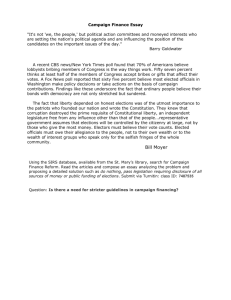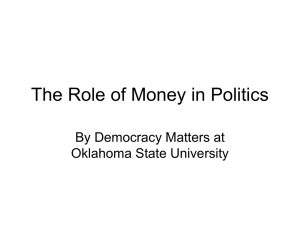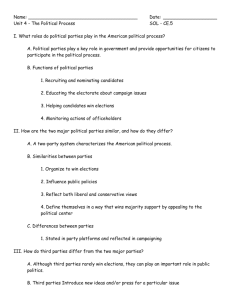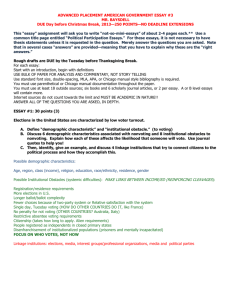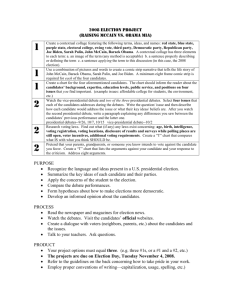Unit III Review Guide 2
advertisement
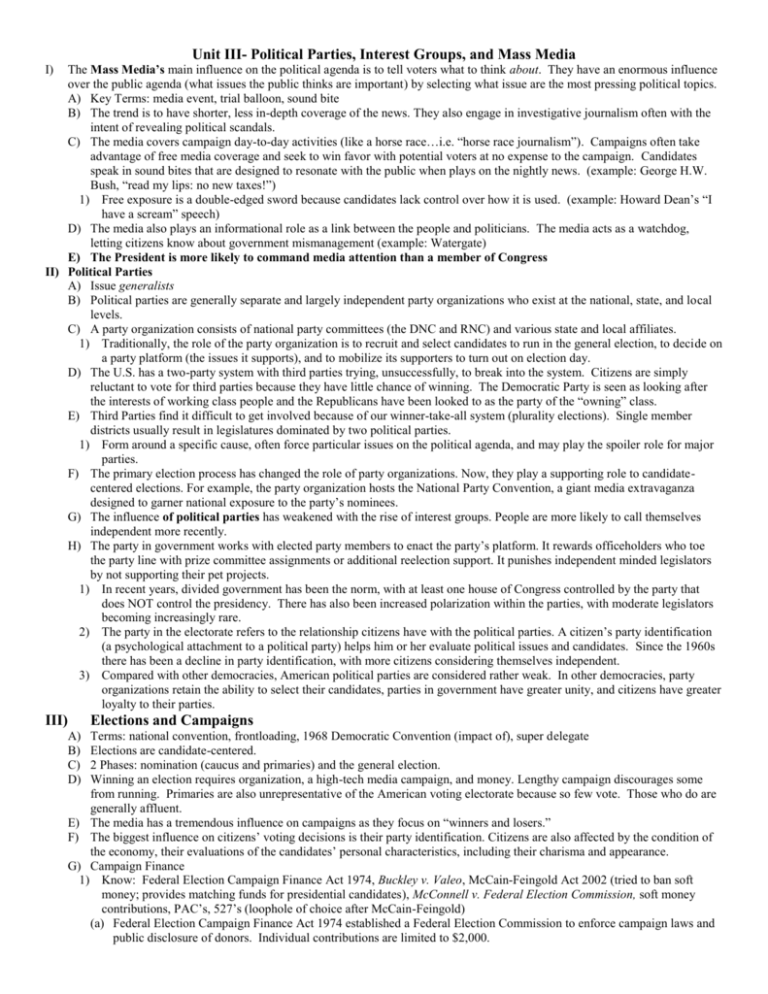
Unit III- Political Parties, Interest Groups, and Mass Media The Mass Media’s main influence on the political agenda is to tell voters what to think about. They have an enormous influence over the public agenda (what issues the public thinks are important) by selecting what issue are the most pressing political topics. A) Key Terms: media event, trial balloon, sound bite B) The trend is to have shorter, less in-depth coverage of the news. They also engage in investigative journalism often with the intent of revealing political scandals. C) The media covers campaign day-to-day activities (like a horse race…i.e. “horse race journalism”). Campaigns often take advantage of free media coverage and seek to win favor with potential voters at no expense to the campaign. Candidates speak in sound bites that are designed to resonate with the public when plays on the nightly news. (example: George H.W. Bush, “read my lips: no new taxes!”) 1) Free exposure is a double-edged sword because candidates lack control over how it is used. (example: Howard Dean’s “I have a scream” speech) D) The media also plays an informational role as a link between the people and politicians. The media acts as a watchdog, letting citizens know about government mismanagement (example: Watergate) E) The President is more likely to command media attention than a member of Congress II) Political Parties A) Issue generalists B) Political parties are generally separate and largely independent party organizations who exist at the national, state, and local levels. C) A party organization consists of national party committees (the DNC and RNC) and various state and local affiliates. 1) Traditionally, the role of the party organization is to recruit and select candidates to run in the general election, to decide on a party platform (the issues it supports), and to mobilize its supporters to turn out on election day. D) The U.S. has a two-party system with third parties trying, unsuccessfully, to break into the system. Citizens are simply reluctant to vote for third parties because they have little chance of winning. The Democratic Party is seen as looking after the interests of working class people and the Republicans have been looked to as the party of the “owning” class. E) Third Parties find it difficult to get involved because of our winner-take-all system (plurality elections). Single member districts usually result in legislatures dominated by two political parties. 1) Form around a specific cause, often force particular issues on the political agenda, and may play the spoiler role for major parties. F) The primary election process has changed the role of party organizations. Now, they play a supporting role to candidatecentered elections. For example, the party organization hosts the National Party Convention, a giant media extravaganza designed to garner national exposure to the party’s nominees. G) The influence of political parties has weakened with the rise of interest groups. People are more likely to call themselves independent more recently. H) The party in government works with elected party members to enact the party’s platform. It rewards officeholders who toe the party line with prize committee assignments or additional reelection support. It punishes independent minded legislators by not supporting their pet projects. 1) In recent years, divided government has been the norm, with at least one house of Congress controlled by the party that does NOT control the presidency. There has also been increased polarization within the parties, with moderate legislators becoming increasingly rare. 2) The party in the electorate refers to the relationship citizens have with the political parties. A citizen’s party identification (a psychological attachment to a political party) helps him or her evaluate political issues and candidates. Since the 1960s there has been a decline in party identification, with more citizens considering themselves independent. 3) Compared with other democracies, American political parties are considered rather weak. In other democracies, party organizations retain the ability to select their candidates, parties in government have greater unity, and citizens have greater loyalty to their parties. I) III) A) B) C) D) Elections and Campaigns Terms: national convention, frontloading, 1968 Democratic Convention (impact of), super delegate Elections are candidate-centered. 2 Phases: nomination (caucus and primaries) and the general election. Winning an election requires organization, a high-tech media campaign, and money. Lengthy campaign discourages some from running. Primaries are also unrepresentative of the American voting electorate because so few vote. Those who do are generally affluent. E) The media has a tremendous influence on campaigns as they focus on “winners and losers.” F) The biggest influence on citizens’ voting decisions is their party identification. Citizens are also affected by the condition of the economy, their evaluations of the candidates’ personal characteristics, including their charisma and appearance. G) Campaign Finance 1) Know: Federal Election Campaign Finance Act 1974, Buckley v. Valeo, McCain-Feingold Act 2002 (tried to ban soft money; provides matching funds for presidential candidates), McConnell v. Federal Election Commission, soft money contributions, PAC’s, 527’s (loophole of choice after McCain-Feingold) (a) Federal Election Campaign Finance Act 1974 established a Federal Election Commission to enforce campaign laws and public disclosure of donors. Individual contributions are limited to $2,000. (b) Buckley v. Valeo declared limits on campaign spending unconstitutional on free speech grounds. 2) Recent proposals: eliminate soft money contributions (general; to the political party), limit individual expenditures, and raise limits in individual contributions. FEC v Citizens United 2010 allows corporations to donate unlimited support. H) The Electoral College (Ch. 10). Make sure you fully understand how it works and that you can distinguish between plurality and proportional elections. (The Electoral College is a type of plurality election) 1) “Winner take all” feature has many implications for Presidential races. How affect campaigns? (a) Resource allocation (often focus on larger states) (b) Issues (appeal to voter bloc in specific state) (c) Choice of a vice president (d) How affect third parties? (i) May get much popular vote, but if not a majority they cannot get electoral votes. (ii) The fact that they may not win hampers their ability to raise money and gain other campaign resources. 2) Why has it not been abolished? (a) Helps ensure that a majority of electoral votes (f) Racial minorities in some states like the electoral are earned by one candidate. college because it protects their votes. (b) History/tradition (g) Collectively it benefits the large states (c) Would require a constitutional amendment (h) Competitive states like it (d) No clear consensus on an alternative (i) Favors a two-party system (e) Collectively benefits small states IV) 70% of Interest Groups have been established since the 1970’s A) In Federalist #10, Madison argued that factions are natural, but controllable through the checks and balances and separation of powers built into our political institutions. B) Issue specialists. Try to influence legislators through providing legislators with information on technical issues. C) Primary goal is to help candidates win elections. They benefit democracy by representing the interests of minorities and those with more intense political beliefs. A disadvantage is that wealthier interests tend to be more successful. D) Majority of money goes to Congressional incumbents. E) Know: Pluralists, Hyperpluralists (sub governments or iron triangles composed of interest groups, bureaucracies, and committees of Congress), and Elite Theories of Interest Groups F) Methods: Lobbying, Campaign Contributions, Litigation, Grassroots Campaigns (to mobilize public opinion), voter guides that offer voting advice, endorsement of specific candidates, amicus curiae briefs (“friend of the court”). G) Types 1) Economic Interest Groups: Business/labor is the fastest growing since the mid-1970’s. They look after the financial interests of their members. Examples: AFL-CIO 2) Public Interest Groups: examples: American Civil Liberties Union, National Rifle Association. Motivated b the desire to improve society but differ greatly in what that means. 3) Environment: Greenpeace, League of Conservation Voters 4) Equality: NAACP 5) Consumer Interests H) The larger an interest group, generally, the less mobilized and successful they are (collective goods, free rider problem) Possible FRQ’s for Unit 3- Political Parties, Interest Groups, and Mass Media 1. One of the most important ways the news media influence politics is through agenda setting. a) define policy agenda b) explain how the national news media engage in agenda setting. c) explain the primary reason the president tends to have an advantage over Congress in gaining media attention. d) Consider the table above. Describe the difference in the viewing patterns of older and younger age-groups. Describe the change from 1974 to 2002 in viewing habits that exists for all age categories. e) Given the information in the table, describe one implication for presidents in their use of the media to promote their political and policy objectives to the American public. Principles Drawn from Released MC’s and FRQ’s (Mass Media) The news media’s most important influence on public opinion is that it affects which issues the public thinks are important. The largest amount of political coverage in newspapers during Presidential campaigns is devoted to day-to-day activities. A policy agenda is a set of issues, problems, or subjects that gets the attention of/is viewed as important by people involved in policymaking (e.g., government officials, government decision-makers) The news media engages in agenda setting by: raise awareness, provide information, draw attention, demonstrate the important or consequences of the problem, get the public’s attention, or getting the attention of government/policymakers. The president has an advantage over members of Congress in gaining media attention because the president speaks with a single voice, while Congress has many voices, the president represents the nation, members of Congress represent states/districts, the president is the national leader/leader of the country, the president is more powerful than any single member of Congress, the president has constitutional powers that Congress does not have. Young people view less TV news than older people/Older people view more TV news than younger people. People in all categories viewed less TV news in 2002 than they did in 1974. Political Parties 1. Minor parties (third parties) have been a common feature of United States politics. a. Describe the point of view expressed about minor parties in the political cartoon above. b. Identify and explain how two rules of the United States electoral system act as obstacles to minor-party candidates winning elections. c. Minor parties make important contributions to the United States political system in spite of the institutional obstacles to their candidates’ success. Describe two of these contributions. 2. While interest groups and political parties each play a significant role in the United States political system, they differ in their fundamental goals. a. Identify the fundamental goal of interest groups in the political process. b. Identify the fundamental goal of major political parties in the political process. c. Describe two different ways by which interest groups support the fundamental goal of political parties in the political process. d. For one of the forms of support you described in (c), explain two different ways in which that form of support helps interest groups to achieve their fundamental goal in the political process. Elections and Campaigns Principles Drawn from Released MC’s and FRQ’s (Political Parties) Goals of political parties: Elect people to office, gain control of government. Know which groups tend to vote for which parties: o For example: Each of the following was a part of the New Deal electoral coalition: Blue-collar workers, racial minorities, Southerners, and Farm laborers The winner-take-all electoral system makes it difficult for third parties to emerge and survive. The decline of Democratic Party strength among White southerners was evident in presidential elections in the 1980’s. In the 1992 election, the membership of Congress was altered significantly by an increase in the number of minorities and women. Critical elections in the United States typically have occurred when groups of voters have changed their traditional patterns of party loyalties. The percentage of voters identifying themselves as either Democrats or Republicans has been declining since the 1970’s. Political parties have declined in importance in recent years and interest groups have risen in importance very quickly. This is because interest groups are better able to articulate specific policy positions than political parties. The following act as major obstacles to third parties: Winner-take-all aspect of electoral college, ballot access, campaign financing (rules/limits, not effects), federal funding of presidential elections, exclusion from presidential debates, singlemember plurality districts Contributions of third parties include: New or different ideas or issues, voice for fringe, safety valve or discontent, enhanced participation, room for critical voices, pushes major parties to include otherwise underrepresented concerns/groups, clarify major-party candidates’ positions. Elections and Campaigns 1. Over the last half of the twentieth century, voter turnout in federal elections has declined. During the same period, voter turnout has been higher in presidential elections than in midterm elections. a) Identify two factors that have contributed to the overall decline in turnout in federal elections and explain how each factor has contributed to the overall decline. b) identify and explain two reasons why voter turnout has been higher in presidential elections than in midterm elections. 2. Trust and confidence in government have declined in recent decades. a) Explain how divided government has contributed to the decline in trust and confidence in government. Be sure to include a definition of divided government in your response. b) Explain how the increased cost of election campaigns has contributed to the decline in trust and confidence in government. c) Explain two specific consequences of the decline in trust and confidence in government for individual political behavior. 3. The United States Congress has debated a variety of campaign finance reforms over the last decade. The proposals debated have included the following: Eliminating soft money Limiting independent expenditures Raising limits on individual contributions a) Select on of the listed proposals and do all of the following: Define the proposal. Describe an argument that proponents make in favor of the proposal. Describe an argument that opponents make against the proposal. b) Select a different listed proposal and do all of the following: Define the proposal Describe an argument that proponents make in favor of the proposal Describe an argument that opponents make against the proposal. 4. Have changes in the formal presidential nomination procedures since the mid-1960’s made the process more democratic? In your response, support your argument by describing three specific changes in the procedures and discussing their effects. 5. Since the 1960’s, the process of selecting presidential candidates has been altered by the changing role of presidential primaries and national party conventions. Discuss FOUR effects that have resulted from this change in the presidential selection process. 4 Elections and Campaigns 6. The concept of iron triangles, also referred to as sub governments, is used to explain how various interests influence public policy. Applying this concept to agriculture, briefly identify the key players in the iron triangle, analyze how they interact to achieve policy goals, and evaluate the impact of this iron triangle on the democratic process. 7. In the 1990’s, presidential election campaigns have become more candidate centered and less focused on issues and party labels. This change has been attributed both to how the media cover presidential campaigns and to how candidates use the media. Identify and explain two ways in which the media have contributed to candidate-centered presidential campaigns. Identify and explain two ways in which presidential candidates’ use of the media has contributed to candidate-centered campaigns. 8. Three obstacles have made it difficult for Congress to enact Campaign Finance reform Buckley v. Valeo Incumbency Soft money Select two of the obstacles. For each obstacle, provide each of the following: a) a brief description of the obstacle. b) an explanation of how the obstacle has made it difficult to enact significant Campaign finance reform. Principles Drawn from Released MC’s and FRQ’s (Elections and Campaigns) Campaign finance reforms have attempted to minimize the role of money in influencing the outcome of an election, as was often the case in the past. The use of direct primaries instead of the convention system to select presidential candidates has resulted in: a weakening of party control over nominations and an increase in the number of people involved in the choice of candidates. Reforms to the presidential nomination process have resulted in the number of female delegates and minority-group delegates at Democratic national conventions growing substantially. *The boundary lines of congressional districts are drawn by state legislatures.* Voters in presidential primary elections are more likely to be affluent compared to voters in a general election. A primary election in which voters are required to identify a party preference before the election and are not allowed to split their ticket is called a closed primary. A significant trend in the presidential nominating process over the past three decades is the increasing importance of presidential primaries rather than state conventions. Public monies are only used to help finance Presidential campaigns (not congressional or gubernatorial) An election involving more than two candidates in which the person who receives the most votes is the winner is called a plurality election. The increased cost of election campaigns has contributed to the decline in trust and confidence in government because: Candidates must spend more time raising money, Role of interest groups (PAC’s), corporations and connections to wealthy donors, Keeps good people from running for office, Small contributions don’t matter, Perception that there is wasteful spending. The United States Congress has debated a variety of campaign finance reforms over the last decade. The proposals debated have included the following: Eliminating soft money, Limiting independent expenditures, and Raising limits on individual contributions. Arguments have been made in favor and against reforming each: Eliminating soft money Definition: prohibiting or regulating campaign contributions to political parties and/or contributions for party building activities Acceptable arguments in favor include: Soft money is often used to circumvent limits on hard money Levels the playing field. Lessens concern about the undue influence of “fat cats”/buying of influence. Provides more disclosure and transparency. Decreases overall costs of campaigns Acceptable arguments against include: First Amendment Contrary to ruling in Buckley v. Valeo Party money is one step removed between contributor and decision-maker. 5 Elections and Campaigns Weakens political parties. Limiting Independent expenditures Definition: Limiting money spent by individuals and groups not directly affiliated with the candidate or the party Acceptable arguments in favor include: Can be used to circumvent limits on hard money. Levels the playing field. Possibly reduces negative issue ads. Candidates want to control their own campaigns. lessens concern about undue influence of “fat cats”/buying of influence. Might lessen grassroots participation. Acceptable arguments against include: First Amendment Contrary to ruling in Buckley v. Valeo. Might lessen grassroots participation Raising limits on individual contributions Definition: Increasing the dollar amount individuals may give to a campaign, parties, or PAC’s Acceptable arguments in favor include: Limits are not indexed to inflation. Candidates can spend less time fundraising Decreased the influence of PAC’s Decreased restrictions on First Amendment rights. Decreased reliance on less-regulated forms of campaign funds. Acceptable arguments against include: Allows the rich to have/buy more influence Too much money in the process already. Drives up the cost of campaigns. 6 Elections and Campaigns Interest Groups 1. While interest groups and political parties each play a significant role in the United States political system, they differ in their fundamental goals. a. Identify the fundamental goal of interest groups in the political process. b. Identify the fundamental goal of major political parties in the political process. c. Describe two different ways by which interest groups support the fundamental goal of political parties in the political process. d. For one of the forms of support you described in (c), explain two different ways in which that form of support helps interest groups to achieve their fundamental goal in the political process. 2. Different interest groups will choose different techniques to achieve their objectives based on their resources, characteristics, and goals. a. Describe each of the following techniques and explain why an interest group would choose each technique. Litigation Campaign Contributions Grassroots lobbying/mass mobilization b. Select one of the following groups and identify the primary technique it uses from the list in part (a). Explain why the group you selected would employ that technique over the other two techniques. American Medical Association (AMA) Sierra Club National Rifle Association (NRA) National Association for the Advancement of Colored People (NAACP). Principles Drawn from Released MC’s and FRQ’s (Interest Groups) Interest groups and political parties promote U.S. democracy by linking citizens to the political process. Fundamental goals of interest groups include: Influence public policy, Influence Congress/government, Change laws Interest groups support their goals by: Access/influence policymakers, Have like-minded people/policy advocated in office, and Legislation that helps interest groups The actions that support these goals: Monetary contributions/political action committee (PAC) donations, Organization/mobilization of people, Media campaigns, Information, Independent committees/527s, Independent expenditures, Endorsement/recruitment of candidates Unions engaging in strikes is recognized by law. The following groups are examples of those who maintain a national lobbying organization in Washington D.C: Environmentalists, nurses, automobile manufacturers, automobile assembly-line workers Interest groups influence the political process by: lobbying, contributing money to candidates, filing lawsuits, appealing to public opinion. Interest groups are better able to articulate specific policy positions than are political parties. Corporate lobbyists influence Congress by: ensuring corporation’s PAC’s make donations to the campaigns of members in key committees, meet informally with aids over lunch or cocktails, bring influential constituents to Washington to discuss important policy matters with their representatives. They do NOT have any influence over the Judicial Branch. The primary function of PAC’s is to raise campaign funds to support favored candidates. PAC spending makes up a higher percentage of congressional campaign funds than of presidential campaign funds. The amount of money that PAC’s can contribute directly to a candidate is limited by law. In The Federalist Papers, Madison expressed the view that factions are undesirable but inevitable in a free society. The following are the major ways that interest groups influence policy: 1. Litigation- lack broad popular support (numbers or pub opinion) and /or lack influence over legislation/policy, rights issues involved, success establishes firm precedent 2. Campaign contributions- financial resources, groups that need access, narrow or focused issue, buy candidate loyalty/support. Groups can recruit/endorse candidates that will support their positions to run for public office, provide testimony, and get members to work for candidates; some form PACs 3. Grassroots lobbying (not lobbying in general)/Mass mobilization- popular support but lack of funds, popular support is strength, requires less other resources ($, access), democratic concerns (philosophical approach). 4. Lobbying- are a source of information, help politicians plan political strategies for legislation, help politicians plan political strategies for reelection campaigns, are a source of ideas and innovations. 7


